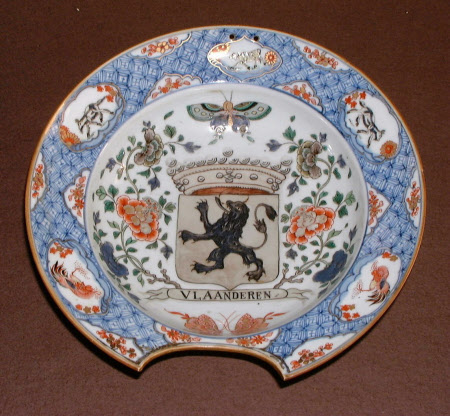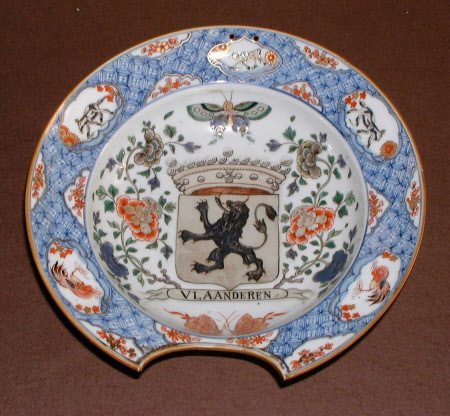Shaving bowl
Category
Ceramics
Date
1713 - 1725
Materials
porcelain, underglaze cobalt blue, overglaze polychrome enamels
Measurements
75 mm (Height); 249 mm (Diameter); 275 mm (Diameter)
Place of origin
Jingdezhen
Order this imageCollection
Wallington, Northumberland
NT 581800
Summary
Shaving basin or barber's bowl for the Dutch market, porcelain, bowl with wide rim with semi-circular notch in the rim to rest beside the neck, Jingdezhen, Jiangxi province, China, c. 1720; decorated in underglaze cobalt blue and translucent overglaze polychrome (famille verte) enamels, painted with a central coat-of-arms with a rampant lion surmounted by a coronet and bearing the inscription on a banner 'VLAANDEREN'(Flanders), flanked by large peony blooms and butterflies, the gilt brown-edged rim decorated with an underglaze blue trellis-pattern band reserved with various lobed cartouches of flowers, a goat, cockerels, a buffalo and fox, with two suspension holes pierced at the top.
Full description
A series of large dishes and shaving bowls or barber's basins were ordered by the Dutch East India Company with the heraldic emblems of Netherlandish provinces and towns in at least three designs, of which this shaving basin represent the earliest style, identifiable by its pentagonal panels. For a similar dish with the arms of HOLLAND, see the Rijksmuseum, AK-NM-13588. The four famous 'Provinces' patterns, each comprising twenty-three different arms of the principle towns and provinces of present-day Belgium and the Netherlands plus of England and France, were made around 1720, possibly inspired by the 1717 Triple Alliance marking a new rapport of England, France and the Netherlands, see Clare Le Corbeiller posits (China Trade Porcelain: Patterns of Exchange, 1974, pp. 37-39).
Provenance
Gift from Sir Charles Philips Trevelyan 3rd Bt
Marks and inscriptions
Base of bowl: Written in black ink - Library East door l (paper label) Base of bowl: Small white circular sticker, written in blue ink - 202


